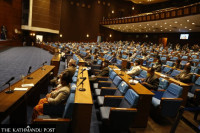Politics
Constitutional options for new government
Advocates say the President can cite Article 76 (2) to install another majority government.
Post Report
The Nepali Congress and the CPN-UML sealed a mid-night deal on Monday agreeing to form a new government ousting Pushpa Kamal Dahal as prime minister.
According to the deal, KP Sharma Oli, the UML chairman, will lead the coalition for the first half of the three-and-a-half years until the next election. He will hand over the premiership to Congress President Sher Bahadur Deuba, who will oversee the elections. However, how soon Oli will move into Baluwatar from Balkot will depend on Dahal’s decision.
The UML, the senior coalition partner in the Dahal government, hasn’t recalled its ministers from the Cabinet. Nor has it withdrawn its support to the prime minister. Its secretariat meeting on Tuesday asked Dahal to clear the way for a national consensus government by resigning.
"We will look at other constitutional options [quitting the government and withdrawing the support] only if the prime minister refuses to quit," said Rajendra Gautam, the UML's publicity department chief.
Countdown of the CPN (Maoist Centre)-led government will begin the day the UML withdraws its support.
Dahal will then be left with two options: resign or face Parliament. An office bearer meeting of the Maoist Centre decided that the prime minister will not quit but go for the floor test.
Any party that proves the majority in the House of Representatives leads the government, said Devendra Paudel, the Maoist Centre secretary. “The prime minister will not resign,” Paudel said. “He will take the constitutional course [opt for the vote of trust].”
Article 100 (2) of the constitution states that if the political party the prime minister represents is divided or a political party in the coalition withdraws its support, the prime minister shall table a motion in the House of Representatives for a vote of confidence within 30 days.
Dahal will have a month at most, from the day the UML withdraws its support, to go for the trust vote. It will be Dahal’s fifth floor test since he formed the post-election government in December 2022. Last time he faced Parliament was on May 20 after the Upendra Yadav-led Janata Samajbadi Party withdrew its support.
As it is certain that he will lose the vote of confidence without the UML and the Congress backing him, the President will call for the formation of a new government with a two- to three-day deadline.
The provision at hand is Article 76, which deals with government formation. There are four provisions in the constitution for appointing the prime minister. As no party has a majority, the President can call for the coalition government as per Article 76 (2).
The article states that in cases where no party has a clear majority, the President shall appoint as prime minister “a member of the House who can command a majority with the support of two or more parties”.
The first and the second largest parties, the Congress and the UML, have a combined strength of 165, much above the majority mark of 138 in the 275-member House. While the UML has 77 members, excluding the Speaker and a suspended lawmaker, the Congress has 88.
Senior advocate Dinesh Tripathi said there are rumors that the President has to initiate government formation as per Article 76 (3)—a minority government—if Dahal, who was appointed under Article 76 (2), fails the floor test.
“This argument is incorrect. The President can call the parties to form a coalition government as per Article 72 (2) after Dahal fails the vote of confidence,” he said. “Several verdicts by the Supreme Court have clearly said that every available option for government formation can be used.”
In its recent verdict to retain the Hikmat Karki-led government in Koshi Province, the top court said the same constitutional provision can be cited for more than once. Advocate Raju Prasad Chapagain, former chairperson of the Constitutional Lawyers’ Forum, said the Constitutional Bench made a similar ruling while overturning the twin decisions of Oli to dissolve the House of Representatives in December 2020 and May 2021.
“There is no bar for the President to trigger government formation based on Article 76 (2),” said Chapagain. “He can make a call for a minority government as per Article 76 (3) only if a coalition government cannot be installed.”




 10.12°C Kathmandu
10.12°C Kathmandu













